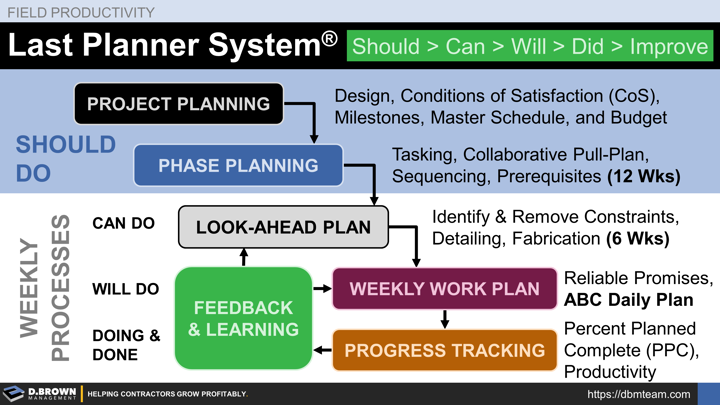Lean Construction Institute (LCI) was formed in 1997 by Glenn Ballard and Greg Howell to share and develop knowledge about building projects. Part of this was adapting manufacturing best practices from Henry Ford through Training Within Industry (TWI) and Toyota for the construction environment.
The Last Planner System (LPS) was developed as a result of research into jobsite productivity indicated only about 54% of the tasks planned for each week were getting completed as planned.
Horrible video quality but great explanation from Greg Howell in 6 minutes.
The Last Planner System (LPS) turns many of the principles and tactics used by the best project teams into something trainable and repeatable. This is critical for coping with the talent shortage in the construction industry, especially for those managers with deep experience developed over decades.
LPS is best if it is used holistically from the project owner through key suppliers as part of Integrated Project Delivery (IPD) but improves any project delivery method including CM-at-Risk (CMAR) which is the preferred delivery method of many of the ENR Top 400 contractors.
Most elements can very effectively be used by individual Specialty Contractors even if their customer isn't using it.
Though it was developed for construction projects, many of the principles apply to business processes, especially as those processes must evolve as a contractor grows.
Here's the basic flow:
Should Do: Starts project planning including Conditions of Satisfaction (CoS), critical milestones, budgeting and cash flow, design development, and a master schedule with long-lead items identified.
Pull planning is typically done for each critical milestone or phase - about 12-week durations. During this process, the trade Foremen (Last Planners) clearly define each task including resources required, optimum sequencing, and prerequisites required before starting the task.
From here, everything becomes routine weekly and daily processes.
Can Do: Look Ahead Plan focusing on identifying and removing constraints 6 weeks out. This includes detailing, approvals, fabrication, deliveries, etc. Jason Mayes explains both the concept and the practical tools. There are technical tools that can help but it is best to start with learning the basic principles which he teaches very well.
Will Do: The Weekly Work Plan built around "Reliable Promises" from the Last Planners (Trade Foremen). This is time to ensure that all 6-Pillars of Task Productivity are met before starting and using ABC Daily Planning to keep things moving forward as-planned.
Remember that this is the stage that research showed only about 54% of weekly tasks were completed as planned and improving that percentage into the 85% range makes project schedules flow much faster.
Did Do: Looking back at the prior week's plan evaluating progress including Percent Planned Complete (PPC).
Each day and each week are cycles for continuous improvement and learning - Plan, Do, Check, and Act (PDCA) including improvements to standards, training, and feedback systems.
Remember that actual installation speed is rarely the root-cause of poor production - Time-on-Tools (ToT) and not having clarity on the installation standards are far bigger impacts.
The principles and tools behind the Last Planner System (LPS) are similar to systems designed for the business level like Objectives and Key Results (OKRs), the 4-Disciplines of Execution (4DX), or the Entrepreneurial Operating System (EOS) as described in the book Traction.
The system you choose matters far less than your understanding of the foundational principles, your ability to adapt it to your project, company, and team along with your persistence to stick with it over the long-term.
We help contractors grow profitably and sustainably into the next generation and beyond. We look at a contracting business from the highest-level strategic decisions (master plan) through business planning at all levels, and ultimately to the monthly, weekly, and daily operating rhythms that keep everything moving forward.
Contact us to learn more - we will share anything we know that can help.

